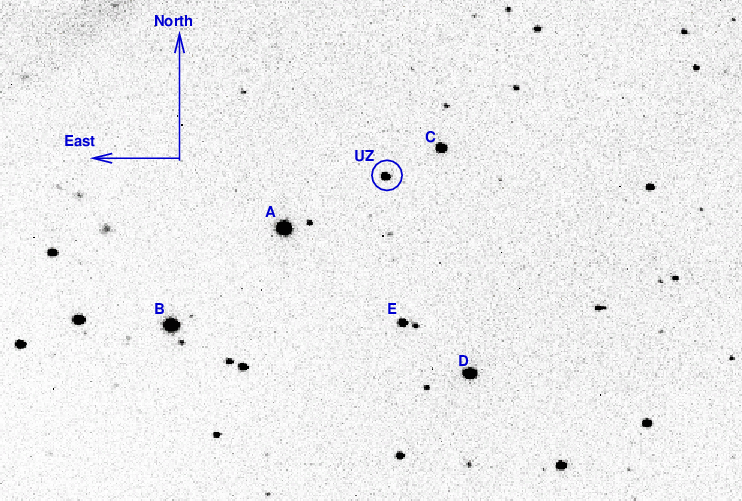
On the night of Aug 24/25, 2013, I observed UZ Boo and SN 2013ej in M74. Conditions were fair -- only a few bits of cirrus. The nearly full moon was very close to M74, though, so it made the background very high.
The main setup was:
Notes from the night
I took a series of images of UZ Boo, using a 150-second exposure time. After 3 V-band exposures showed that the object was very faint, I switched to a clear filter for the remainder of the observations.

The zero-point offset graph shows clouds a slow, steady rise as UZ Boo slowly set. We also see a bifurcation in the second half of the run. I think what is happening is that every other (or every third) image is slightly trailed, due to periodic error in the mount's gears.
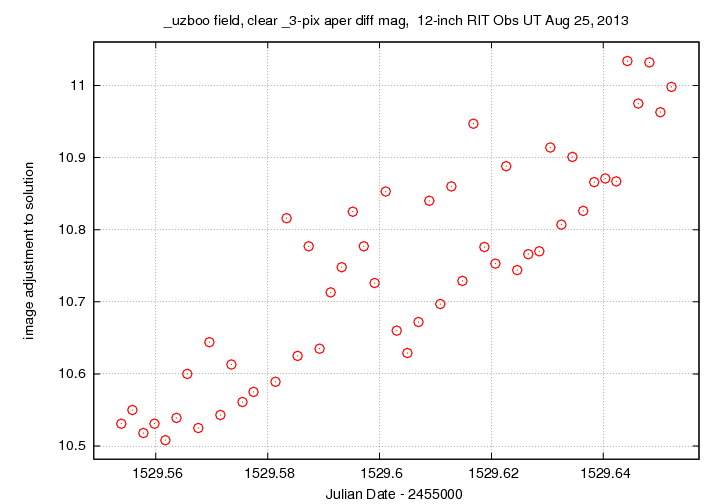
I measured UZ Boo and many other stars in the field, using an aperture 3 pixels (5.6 arcsec) in radius. Since I used a clear filter, the bright stars "A", "B" and "D" were saturated, and were not included in the ensemble solution. I used the star "E" = UCAC4 561-055129 = AAVSO 000-BBV-649 to shift the instrumental magnitudes to the standard scale. These measurements are made with a "clear" filter, but I'll shift them to match the V-band scale: 000-BBV-649 has mag V = 14.267 according to the AAVSO chart 12447AMF.
Below are light curves for UZ Boo and several of the unsaturated stars in the field.
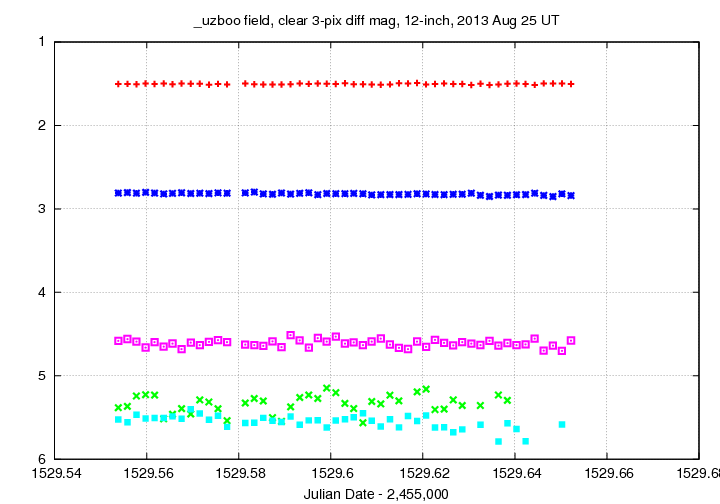
Here's a closeup of UZ Boo and stars of similar faintness. The noise is very large.
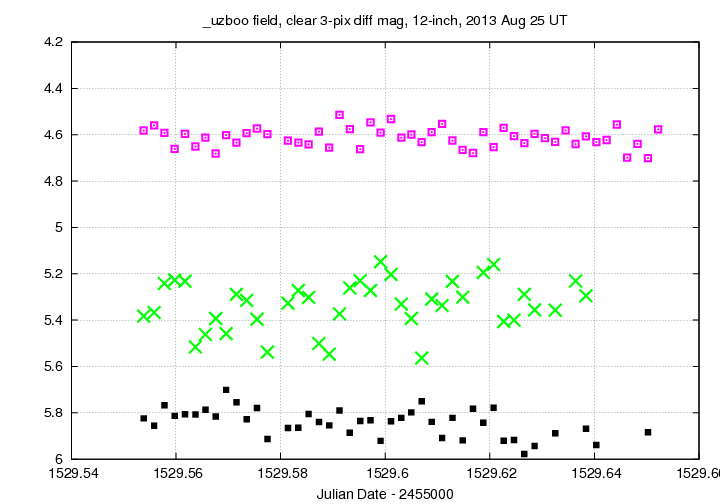
As a check on my practice of shifting the unfiltered measurements to the V magnitude scale, I used the 3 images which I took in the V-band to create a single, deeper median-filtered. In that image, the bright star "A" = UCAC4 561-055134 = AAVSO 000-BBV-651 was not saturated. I used "A" and "E" to determine the offset between the instrumental magnitudes and V-band, and applied the offset to the instrumental magnitude of UZ Boo. The result was V = 17.03, which agrees very well with the average value of "V" = 16.99 from my unfiltered measurements.
The variable star has entered a phase in its evolution in which it fades by about 2 mag, then rebrightens, then fades again, then rebrightens, etc. My measurements at the RIT Observatory catch UZ Boo at several places in this complicated evolution; tonight, it was as faint as I've seen it:
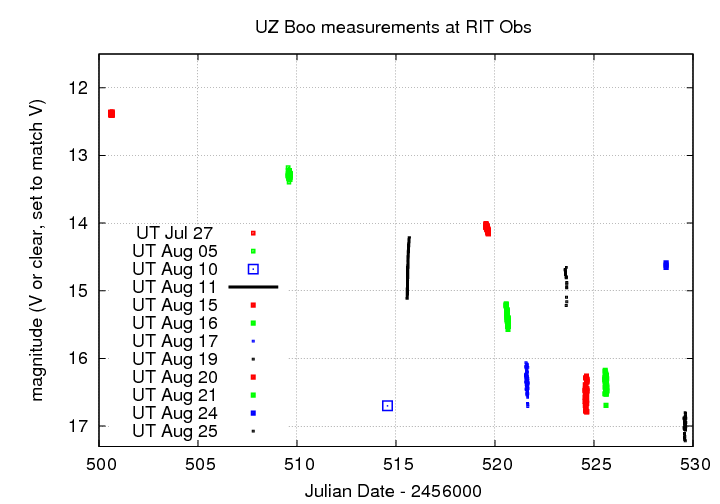
Below are the first few lines of the report I've sent to the AAVSO and VSNet.
# Measurements of UZ_Boo made at RIT Obs, Aug 25, 2013 UT, # in good but bright conditions, # by Michael Richmond, using 12-inch Meade and SBIG ST-8E CCD. # Exposures 150 seconds long, clear filter. # Tabulated times are midexposure (FITS header time - half exposure length) # and accurate only to +/- 1 second (??). # 'mag' is a differential magnitude based on ensemble photometry # using a circular aperture of radius 7.4 arcseconds. # which has been shifted so UCAC4 561-055129 has mag=14.267 # which is its V-band magnitude according to AAVSO. # # UT_day JD HJD mag uncert Aug25.05383 2456529.55383 2456529.55136 17.035 0.079 Aug25.05581 2456529.55581 2456529.55334 17.019 0.079 Aug25.05778 2456529.55778 2456529.55531 16.894 0.072
SN 2013ej is a Type II supernova in the relatively nearby galaxy M74. It was discovered by the KAIT group about one week before maximum light. Here's a chart showing the galaxy, the SN, and some reference stars:
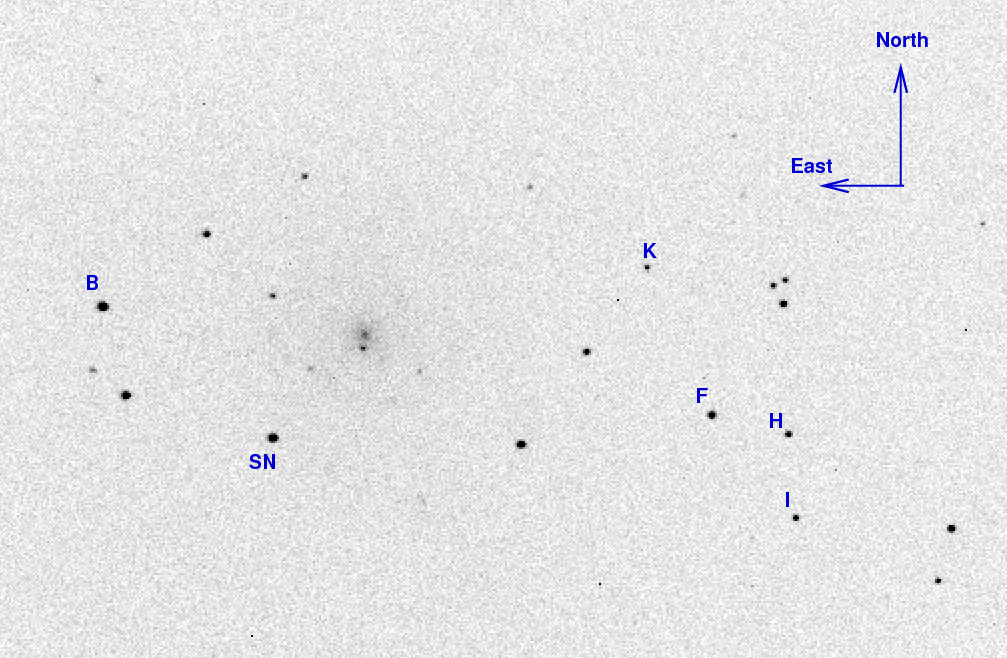
The reference stars marked above have magnitudes in AAVSO chart 12459CA, as follows:
letter B sigB V sigV R sigR I sigI B 13.012 0.019 12.510 0.019 12.154 0.019 11.834 0.019 F 13.848 0.026 13.065 0.022 12.622 0.025 12.152 0.027 H 14.338 0.029 13.692 0.024 13.329 0.029 12.964 0.030 I 14.832 0.027 13.912 0.023 13.416 0.026 12.939 0.030 K 15.192 0.034 14.613 0.027 14.275 0.034 13.915 0.036
I took 30-second unguided images -- the sky was so bright that I couldn't hold the guide star reliably. Moreover, the nearly full Moon was just 6 degrees (!) from M74. Fortunately, as I took images of M74, the Moon happened to be partially hidden behind a pine tree. It rose out of the branches as I was finishing with I-band images of M74. After discarding the bad images, I was left with 4, 4, 4, and 4 images in B, V, R, and I, respectively.
Using aperture photometry with a radius of 4 pixels (radius of 7.4 arcsec), I measured the instrumental magnitudes of a number of reference stars and the target. Following the procedures outlined by Kent Honeycutt's article on inhomogeneous ensemble photometry, I used all stars available in each image to define a reference frame, and measured each star against this frame. I used the AAVSO magnitudes, plus color terms to convert the ensemble instrumental magnitudes to the standard Johnson-Cousins BVRI scale.
The transformation from instrumental to Johnson-Cousins magnitude had a larger uncertainty in the B-band and R-band than usual. I made no changes in B, but saw that star "K, the faintest of the R-band reference stars, was about 0.1 mag away from the other reference stars in zeropoint. I discarded it from the R-band solution.
Results from this evening are:
filter mag mag_uncert Julian Date B = 13.939 +/- 0.090 (ens 0.052 zp 0.074) 2456529.66734 V = 12.904 +/- 0.027 (ens 0.012 zp 0.024) 2456529.66439 R = 12.507 +/- 0.030 (ens 0.025 zp 0.017) 2456529.66224 I = 12.290 +/- 0.038 (ens 0.032 zp 0.020) 2456529.67131
The uncertainties here are roughly equally distributed between extracting the instrumental magnitudes and transforming the instrumental magnitudes to the standard scale.
Grab the text file below for all the RIT measurements of SN 2013ej. All these values have been recomputed with the new color terms of UT 2013 Aug 05.
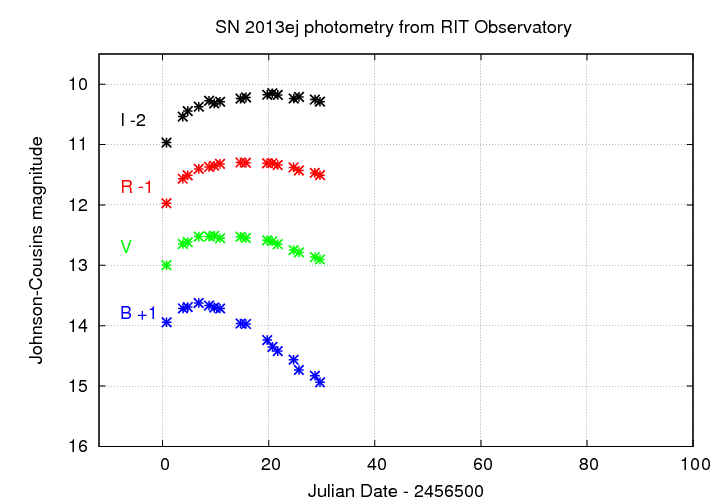
Last modified 08/26/2013 by MWR.